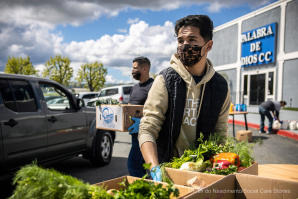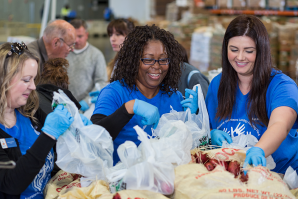You’ll find them standing in a corner of Davis’ Central Park every weeknight after dark, barely lit by a nearby streetlight, surrounded by cardboard boxes and plastic bags. They’re not pushy, but show interest and someone is likely to approach you. “Can I get you anything?” he or she may ask, pulling back the plastic to reveal loaves of bread, bunches of kale, peaches and plums.
This is the Davis Night Market, a grassroots organization that has been operating under the radar for over half a decade. The group has a straightforward mission: redirecting surplus food from Davis’ restaurants and vendors to people who want to eat it. It has no requirements for its beneficiaries; anyone who finds them in Central Park — Monday through Friday, 9-11 p.m. — can take food for free, no questions asked.
The Night Market is one of many food redistribution organizations that have proliferated across California and the country, especially since the pandemic, in response to the paired crises of food insecurity and food waste. It began in 2019 through the combined efforts of a number of Davis residents involved in national and regional food justice organizations, including (among others) Ernst Oehninger, co-founder of freedge; Deema Tamimi, founder of Land & Ladle; and Evan Dumas, then the UC Davis chapter president of the Food Recovery Network. When the COVID-19 shutdowns began the following year, the fledgling nonprofit helped distribute excess restaurant food to people in need.
The world has changed a lot since the pandemic, and so has the makeup of the non-hierarchal organization, in keeping with the high turnover of a college town. But the continued success of the organization suggests that radical simplicity and a genuine focus on community may be the path to longevity for grassroots organizations.
More than food recovery
On a warm June evening, a family with two children playing with light-up toys wander up to the Night Market’s station. The father asks if there are any cookies left. “No, sorry, but we have some bread here,” says Max Morgan, longtime volunteer and de facto leader of the evening, pointing to some loaves donated by Village Bakery. The boys eye the ears of corn piled nearby, but in the end they leave with a loaf.
Other food recipients that evening include UC Davis students, friends of the organization and first-time visitors who happened to stroll past. The park remains busy with people taking walks or heading downtown well into the evening, lending the Night Market a warm, village-like atmosphere.
Morgan, a math and science tutor with an unshakeable teacher’s bearing, encourages each of the volunteers to show off the skill sets they’ve developed through the organization. Vanessa Cruz shyly displays her drawings — happy animals interacting with some of the goods one might find there. A raccoon munches on sweets, a bobcat cuddles blankets. Cruz, an animal science student at UC Davis, hopes to make her drawings into stickers or other marketing materials.
Volunteer Abigail Milro discovered another skill through the Night Market: deescalation. “We’re welcoming to all different kinds of people, so people come in different states of mind,” she says, describing one visitor who “took Night Market as her auditorium” and recited “loud, angry poetry” about her experiences living on the street. Milro says she sat down with the woman and talked to her until she calmed down. She left at peace and with cookies.
Abigail Milro, left, says that the Night Market helped her build
confidence and set boundaries as she transitioned out of
homelessness.

“That moment was kind of magical for me,” says Milro, who has also experienced homelessness and first encountered the Night Market because she needed resources. She says volunteering with the group helped her build confidence, set boundaries and establish herself in the town she now calls home. “That’s why I’m always going to say it’s more than just the food, but what food does,” she says. “Food brings people together.”
A special corner
The Night Market’s mission may be simple, but the systems it works in are often arcane. In order to legally distribute prepared food, volunteers must divvy up individual servings in a licensed commercial kitchen — they currently lend one from a friend of the organization who wants to remain anonymous. Alternatively, they can pack up the food in the kitchen of the restaurant that donated it; on Friday, boxes of leftover rice from the Thai restaurant Sofia’s appear after the restaurant closes at 9.
Morgan has a bone to pick in particular with SB 1383, California’s anti-food-waste law that began going into effect in 2022. “It’s more about cutting greenhouse gas emissions than feeding people,” he says. Still, the group gets by on what he calls a “shoestring of a shoestring” budget; they spent about $2,000 last year, he says.
Christy Mei Vong, right, officer of the UC Davis chapter of the
Food Recovery Network, brought Raeva Johnson to the Night Market
to pick up bread from Village Bakery.

He also admits that it may be difficult to replicate the Night Market model in other communities. Davis, a relatively low-crime town with a large student population and infrastructure focused on bicycle and foot traffic, is unusual in the region and the country as a whole. “How many communities have this — people just walking by late at night?” asks Morgan. “We’ve talked about expanding to Sacramento or to Berkeley or Oakland, but they just don’t have a lot of places that have this much walk-by traffic.”
But Connor Gorman, a volunteer who came across the Night Market while working on his Ph.D. in physics at UC Davis, says that the Night Market is part of a long tradition of mutual aid, memorably associated with the Black Panther Party in Oakland. “Fundamentally, mutual aid is political on its own,” he says. “It shows the way that communities can engage collectively in mutual support outside of oppressive systems and provide for each other.”
In that way, the market is one of those little pockets of utopia you can find all across the Capital Region if you take the time to look. “I have a super special place in my heart for this little, tiny corner,” Milro says before leaving with an armful of corn.
–
Subscribe to the Comstock’s newsletter today.
Recommended For You

This Food Box Helps Families and Small Farmers
Growing the Table is a statewide initiative that connects farmers
from underserved communities with families in need.

What a Waste
Californians throw away 11 billion pounds of food each year — a new recycling law aims to reuse it
Food waste recycling is vital to transforming California
into a circular economy. City and state organizations are
creating mandates to get us there.

Out of the Landfill and Into the Compost Pile
Capital Region residents rise to the occasion of new organics recycling law
Separating food waste from trash used to be the stuff of hippies. But, unlike cork sandals, it’s not a matter of taste — it’s state law.

Opinion: Donating Funds is Critical, Donating Time is Priceless
While dollar donations are mission critical and help to keep the
figurative lights on at many nonprofits, hands-on volunteers are
also valuable — and the most in-demand type of volunteer role
needed is board service.



